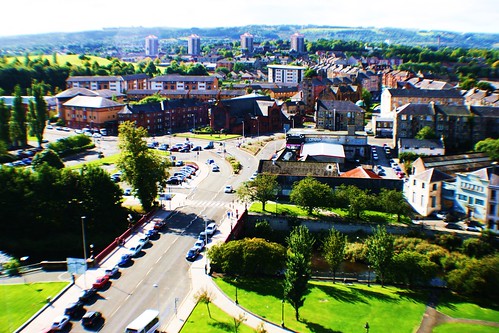Paisley
(Above image is an aerial view of Paisley taken from atop of Paisley Abbey.)
A Brief History of Paisley
- First settled by the Irish monk, St. Mirin in the 6th century. He built a church by the ford on the White Cart Water. (Today, the town’s soccer club is known as St.Mirren.)
- The imposing Abbey was founded in 1163 by Walter Fitzalan, the High Steward of Scotland and from whom the Stewart royal house of Scotland (and Britain’s present Royal Family) is descended.
- Paisley progressively grew and was made a burgh (incorporated or chartered town) in 1488.
- By the 18th century, hand-loom weaving was a major industry.
- In the 19th century major industries had developed, primarily thread-making but also dye-works, brickworks, soap making and whisky distilling. In all of these processes the White Cart Water was instrumental in providing power and water. Paisley is best known for its ‘Paisley pattern’ textiles which are based on a Kashmiri design.
- Today Paisley has a population of some 75,000. The town is now seeking to attract new businesses and recover from the decline of traditional and other manufacturing industries which occurred during the latter part of the 20th century.
Reverend John Witherspoon (1723-1794) : A Paisley church minister who was descended from John Knox and who moved to America. He was the only clergyman to sign the American Declaration of Independence and is ancestor of actress, Reese Witherspoon.
John Witherspoon statue outside Paisley University
Alexander Gardner (1821-1882): A photographer who emigrated to America and photographed the Civil War and building of the Union Pacific Railroad.
Coats Family (19th century): – Peter and brother James managed the family’s prosperous thread-making empire. The family were generous local benefactors.
John Shanks (1827-1895): Patented the first flushing WC.
Marion Robertson: Famous for eponymous Golden Shred marmalade recipe dating from 19th century.
Alexander Wilson (1776-1813):-a poet who emigrated to America in 1794 and recorded local birdlife.
U.S. President, Ronald Reagan:His G.G, Grandmother, Peggy Downie married Claud Wilson at Castlehead Church, Main Road.
Places to See and Visit
Paisley Abbey: Located in centre of the town. Founded 1163 as a monastery which subsequently became an Abbey answerable to Rome in 1245. Burnt by the English in 1307 but subsequently restored. Partly collapsed about 1553 and was not fully restored and rededicated until 1928. It is possible that William Wallace (aka 'Braveheart') was educated at the Abbey.
Paisley Abbey with Alexander Wilson statue in foreground.
Interior of Paisley Abbey
Coats Observatory: Located on Oakshaw Street. Donated by the wealthy Coats thread-making family.
Paisley Museum, Art Galleries & Library: A wealth of knowledge and information located on the High Street.
Thomas Coats Memorial Church: Located on the High Street. Sometimes called the ‘Baptist Cathedral of Europe’ . Stunning interior on which no expense was spared.
Sma’ Shott Cottages: On Shuttle Street. Living and working conditions in the 19th century.
Threadmill Museum at Seed Hill Road: Learn about the Paisley textile mills of bygone years.
Most of the above can be visited via a gentle walking tour of the town.
Paisley is about 11 miles west of Glasgow in S.W. Scotland. The town is also the home of Glasgow International Airport.
.© Nigel P Cole/Catswhiskerstours Limited









Comments
Post a Comment